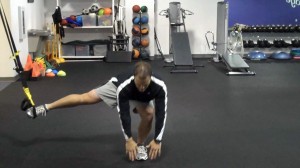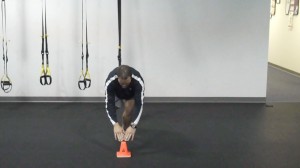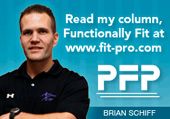Brian Schiff’s Blog
Injury Prevention, Sports Rehab & Performance Training Expert
So, I was meeting with a 14 y/o soccer player referred to me by a physical therapist today who is need of sports performance conditioning (return to play) work after a lateral release. This talented female athlete suffers from a shallow trochlear groove, thereby making her more prone to patella subluxations.
Such an incident led to two recent surgeries and nearly a year away from the soccer field. She has returned to soccer, but has been referred to me for prevention and performance work. I have been thinking about her program, history and all the athletes I have trained in recent memory with knee problems.
I also recall reading an email this weekend from a past intern asking me if there was a single leg training certification out there as she saw me do so much of it at my facility. These thoughts lead me to my post today. If you are a jumping, cutting or competitive athlete using your legs to perform, you should absolutely be integrating single leg training into your conditioning programs.

Why, do I say so? The answer is rather simple in my mind. The human body is often out of balance. The brain is so adept at mastering movement, it learns to compensate for even the slightest deficits on one side. Over time, you end up grooving improper motor patterns and these tend to lead to small imbalances or even overuse issues.
Ever hear about stretch weakness or adaptive shortening? Maybe you are familiar with the terms overactive and under active muscles? Regardless, I can assure you that at any given moment, your body may be susceptible to these patterns.
Through a poper single leg assessment, I see many issues come to light that may otherwise be hidden with two legged squats, lunges, leg press, etc. Let me go back to the young lady sitting in my office this morning. She has bilateral shallow trochlear grooves, yet only one knee to date has given way. Why so? Will the other one follow suit?
There is no way to definitively predict if her other knee will become problematic. But, my hunch is there were some single sided imbalances that may have led to her current injury history. It is now my job to try my best to prevent such an episode on her other knee, as well as make sure she does not have issues on the surgically repaired side.
Anything short of a program heavy on single leg work would be a mistake for her (and many others like her). You see, we often reinforce imbalances and poor technique with heavy squatting, lunging and dead lifts seen in traditional programs. I am not oppose dot these lifts – in fact they can be great for strength and power development.
However, we MUST address and correct the single sided imbalances first. We must also always include some single leg strength work with our athletes to ensure there is no asymmetry developed unknowingly. Most athletes compete using their own body weight. We must train in such a way that we foster control, power and mastery of movement with each limb.
This focus and approach will be most helpful in reducing injuries like ankle sprains, ACL tears, muscle strains and common overuse issues in the lower extremity. So, next time you think about performance training, I want you to consider the importance and relevance of single leg training. No program is perfect. But, I will tell you my track record is pretty solid with prevention, performance and return to play training I have done that relies heavily on this approach to conditioning.
Stay tuned as later this week I will unveil my latest DVD as well as review how traction with footwear affects lower limb joint loading.
Core training is common terminology thrown around in fitness circles today. However, not much research has specifically addressed more advanced stability ball exercises and muscle activation until now.
A recent article released in the May 2010 Journal of Orthopedic & Sports Physical Therapy looked at 8 stability ball exercises and maximal voluntary isometric contraction (MVIC) versus traditional bent knee curl ups and crunches.
The 8 stability ball exercises studied with EMG were:
- Roll out
- Pike
- Knee up
- Skier
- Prone hip extension left
- Prone hip extension right
- Decline push-up
- Seated march right

Pike (end position)
All exercises were performed with a cadence of 1/1/1. A metronome was used to ensure uniform repetitions and holds. Researchers concluded that the pike and roll-out were the most effective exercises based on EMG activation. However, keep in mind that these also require the greatest effort and pose a high degree of difficulty.
Why is this stuff important? Research done by Cholecki and VanVliet concluded that no single core muscle can be identified as the most important for spinal stability. Additionally, they believe that the relative importance of the muscle varies based on the direction and magnitude of the load imposed on the spine.
We have known for years the spine is least stable and most vulnerable in trunk flexion (as in the knee bent curl up), and that no one muscle contributes more than 30% to overall spine stability. Choosing more demanding core exercises also typically increases spinal compressive forces as well. This may be contraindicated in some populations.
Therefore knowing your client and condition is essential. For example, flexion is often contraindicated with active disk pathology, whereas it may be indicated in those with facet arthropathy or spondylolisthesis. Over the past decade or so, much attention has been placed on the transversus abdominus muscle.
The prevalent thinking has been that it is a major contributor to spinal stability, although this is somewhat controversial and has not been unequivocally validated with science. Another flaw here is that isolated contractions of it have not been demonstrated in higher level activities (e.g. sports).
So, where is the functional tie in here? The transeversus abdominus has shown similar activation patterns (within 15%) to the internal obliques with exercises similar to those in this study. The highest activity from internal obliques was during the pike, roll-out, knee up, skier and hip extension left exercise. This may indicate that transveresus abdominus activation is also high, but further research will need to be done.
The last critical piece of data involves looking at hip flexor activation as the psoas generates remarkable spinal compression and anterior shear forces at L5-S1. This can be especially troubling for individuals struggling with lumbar disk pathology. The exercise in this stud that demonstrated moderate hip flexor activation were:
- Bent knee sit-up
- Pike
- Seated march
- Hip extension exercises
So, if you or your client has a weak rectus abdominus and/or obliques or lumbar instability, these exercises may be contraindicated. In the end, know that the stability ball provides much greater muscle activation compared to traditional bent knee sit-ups and crunches on the floor. The caveat is identifying which ones are appropriate and most efficient in your case.
As a general rule, I suggest that you avoid long lever arm action with the legs in the presence of active disk pathology and instability. You may opt for stability based exercises in a neutral spine position like planks as there is minimal shear and compressive loading here until clients develop more stability and strength. With healthy and mroe advanced clientele, many of the stability ball exercises studied would be good alternatives to traditional crunch work to build muscle strength for the core.
I hope you enjoyed part one in this series. Part two looks at a frontal and transverse suspended reach. This is a great way to train the body to better resist shear forces that are encountered in sport.

To read more about this progression and see the rotational component, click here. This exercise is a great way to improve hip strength and improve de-rotational capacity, thereby reducing injury risk with planting, cutting and pivoting.
Throughout my speaking and training, I advocate single leg strengthening. Additionally, I try to incorporate balance and stability training progressions that target common muscle imbalances and reduce injury risk.
It is common knowledge that the hip can often affect the knee. Likewise, the foot and ankle complex can also impact the knee. Single leg training often exposes and corrects limb deficiencies and simulataneously improves function and performance.
I have been producing a TRX functionally fit mini-series for PFP magazine. The first two editions focus on single leg suspension reaching progressions. I thought I would share those with you as there may be portions you can apply to your own training or to others.
I use these progressions with runners, court and field athletes, and general clients alike. They work the entire kinetic chain and emphasize anti-gravity control in multiple planes. These progressions can be part of an advanced rehab regimen or fitness program. Below is a picture of the phase one sagittal plane reach:

To see the entire progression (part 1), check out my column by clicking on the image below.
Anterior knee pain, aka chondromalacia, patellofemoral pain (PFP) and patellofemoral pain syndrome (PFPS), may be the most difficult condition to remedy in the clinic or gym. There is always debate and speculation when it comes to taping, bracing, orthotics and exercise.
In the latest edition of the JOSPT, there was a summary from the findings presented at an international retreat held in the spring of 2009 in Maryland. The publication covered the keynote addresses and podium presentations.
Before I give you the quick and dirty details, I want to emphasize a key point that was made and one I happen to wholeheartedly agree with. It is this:
When assessing and evaluating those with PFPS, it is important to recognize that these patients/clients do not necessarily fit under one broad classification system. The anterior knee pain issue is multi-factorial and not every person has the same issues or abnormalities. As such, the exercise prescription most likely will need to be tweaked accordingly for best results.
Okay, now on to the highlights that may impact your training/rehab. Some researchers from Belgium have been conducting prospective studies looking at intrinsic risk factors for developing PFPS. They looked at physical education students and novice runners. Major findings are included below:
Study #1
There were 4 variables identified as risk factors:
- Decreased flexibility of the quadriceps
- Decreased explosive strength of the quadriceps
- Altered neuromuscular coordination b/w the vastus lateralis (VL) and vastus medialis oblique (VMO)
- Hypermobility of the patella
Study #2
- More laterally directed plantar pressure distribution at initial (foot) contact during walking and more laterally directed rollover are risk factors for developing PFPS
Study #3
- Unable to link hip muscle strength (or weakness) to increasing risk for PFPS
- No apparent correlation with frontal plane motion of the knee and hip strength (so hip weakness will not automatically cause knee pain)
Finally, what does this mean for therapists and fitness pros? It means…….
- They should address the 4 intrinsic risk factors by stretching and strengthening the quads, with a particular emphasis on balancing the VMO strength in relation to VL strength. This is not new information. Spending time on closed chain terminal range strengthening is important.
- Second, keenly observing a dynamic disturbance in foot alignment at contact is important for predicting PFPS and will undoubtedly impact dynamic training protocols for the entire kinetic chain.
- Lastly, continue to strengthen the hip even though the final study revealed no apparent link. However, perhaps focus more on this when there is a definitive weakness side-to-side that has been identified. So, don’t fall back on the weak gluteus medius by default; rather use dysfunction as a driver for exercise inclusion.
PFPS is and will continue to be a difficult problem to treat and remedy with exercise. Further research is needed to determine and evaluate more specific gender differences, kinetic chain links, the efficacy of taping/bracing, and the most effective classification and treatment algorithms for those of us in the trenches. In the meantime, listen to the body and use the best available science and information to move forward with your training.
Reference: JOSPT March 2010


